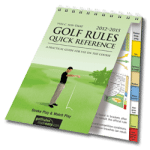Contents
- Interested in becoming a golf club professional.
- How should you go about conditioning yourself for playing in 40 degree weather.
- What is the USGA formula for figuring out your handicap?
- Really interested in becoming a LPGA player.
- Interested in getting a golf scholarship.
- How should I keep my swing in tune during the winter?
- How can I get a junior club started in my county?
- Do you recommend just hitting the ball off the grass or placing it on a tee
- Related Articles on GolfSW.com
Interested in becoming a golf club professional.
Garrick Rudolf (17) of Fargo, North Dakota writes…
I am interested in becoming a golf club professional. What do I have to go through to get certified? Do I have to go to college? If so, what should I major in?
Scott Robbins:
College is not required but in today’s market it is highly recommended. If you want to be a club pro, apply to and get information on the Professional Golf Management Program (PGM) at New Mexico State, Mississippi State, or Ferris State. You might get more information from the PGA of America at www.pga.com. Good Luck. You’ve chosen a great career. Junior Golf Tips
How should you go about conditioning yourself for playing in 40 degree weather.
Andrew Speakes (13) asks…
How should you go about conditioning yourself for playing in 40 degree weather in the dawn of the morning?
Scott Robbins:
The best way is to dress for hit in light layers. Long johns covered by a shirt covered by a light (preferably wool) sweater or sweatshirt and fished off with a light lined jacket. Most importantly is keeping your hands warm. Wear mittens between shots and get some type of hand warmer to keep with you. Junior Golf Tips
What is the USGA formula for figuring out your handicap?
Eric Hettinger (14)of Camas, WA, USA asks…
I was wondering what is the USGA formula for figuring out your handicap?
Scott Robbins:
A handicap is the best 10 of your last 20 scores. Each score should be adjusted for the course rating and then for the slope of the course. Take each score, divide it by the slope of the course and multiply it by 113 (the average slope).
Then take that adjusted score and deduct the course rating. That will give you a number for that round that looks like a handicap. (You shot 79 on a 117 slope and a course rated 72.3. Your adjustment would be 79/117 x 113= 76.3. Subtract 72.5 and your # for that round is 4) Add that number for all best 10 of your last 20 scores and then average those #s and multiply it by .95 and you will have an approximate handicap.
For the most accurate though, check at the course you play and see if they have a handicapping service. My formula could very well be slightly off. Junior Golf Tips
Really interested in becoming a LPGA player.
Angel Mines of Buffalo, NY writes…
I’m really interested in becoming a LPGA player. I would like to know how you got started, and what exactly do I have to do to become a PGA member? I would like to know if you know of any agencies, trainers, schools, or fundings. I’m 15 years of age and I think its time to start reaching my goal, and maybe with your help I can….Thanx.
Scott Robbins:
What a great inspiration to hear a 15 year old that is thinking about her future and has a goal to try to reach. First to become a player on the LPGA Tour is the simplest answer I can give. Study hard and keep up your grades is first and foremost. No matter how good you become as a player, you can’t play college golf if you can’t meet entrance requirements and stay in school once you get there.
Secondly, dedicate as much of your free time as you can to practice, lessons, and playing golf to improve your technique in swinging the clubs and the putter. Third, learn how to shoot low numbers, physically and mentally. Learn to focus one shot at a time and do not be afraid of shooting a real low number. Start doing all this, go to college for more playing experience and try the Tour School.
Second question. How do you become a PGA Professional with schooling, training and funding. There are more and more colleges and Universities offering the PGA of America Professional Golf Management Program (PGM) as a major at their schools. The first was Ferris State but now there are many others including New Mexico State and Mississippi State University. One of my young women students just started at MSU in the PGM program and is playing golf for the school on a golf scholarships. These schools also offer academic scholarships I believe. Each of these programs have requirements that you work the summers for a PGA Professional at a recognized golf facility. All the work you do in school and summers earn you credit towards your PGA Membership.
For more information on the PGM program and the schools offering them, contact the PGA of America at the homepage. It is http://www.pgaonline.com Good luck and I hope to be able to call you a fellow PGA member sometime in the future! Junior Golf Tips
Interested in getting a golf scholarship.
David Agnew of Edmonton, Alberta, Canada writes…
I am currently playing to a 3 handicap and am graduating from high school this year. I am interested in a golf scholarship of some sort, but I don’t know how to go about getting one. How good do I have to be? What is the process I need to go through?
Scott Robbins:
It sounds as if your game is good enough to attain a scholarship for golf. College coaches look at tournament records a lot these days, both scores and number of competitions. If you have any tournament scores, use them to build a resume. Pick out some colleges you would like to attend, call the school and find out who the golf coach is, and call them. Send them your resume and some might ask for a videotape of your swing. There are a lot of smaller schools with funds available. Check with your school counselor. I believe there is a book on scholarships available in the U.S. Junior Golf Tips
How should I keep my swing in tune during the winter?
Geoff Wishlaw of Campbell River, BC, Canada writes…
My question is how should I keep my swing in tune during the winter?
Scott Robbins:
Winter is a great time to mentally work on your game by thinking of swing, strategy and your emotions on the course. It is also a great time to work on your swing. If you have an instructor or coach, have them work with you in front of a mirror to show you what you want to be practicing. Do this without a club and a weighted club or weighted shaft. Use the mirror to work on your set-up (the key to your swing), your takeaway and the position at the top of your swing.
Also take that weighted club and swing it religiously on a nightly basis. Start at 10 times and build up slowly to 50 times a night. Immediately after swinging, stretch then cool down and keep from stretching or damaging your muscles. There are some books of drills and exercises out and I believe they are published by Golf Digest. Check those out. Drill, exercise, strategies, and visualize. Great winter golf “homework.” Good Luck in the Spring! Junior Golf Tips
How can I get a junior club started in my county?
Ryan Stamm (14) of Bellingham, WA writes…
My question is how can I get a junior club started in my county.
Scott Robbins:
What an great and ambitious idea! This is a great time of year to start your planning. The first thing I would do is find the closest PGA Professional in your area. That might even be at the course where you play. Just ask the Head Professional if he is a member of the PGA.
The reason I say that is that PGA Professionals, as part of our training, are well versed in building junior golf programs as well as having access to the PGA of America’s vast resources on Junior Golf. This will take a lot of work to get organized and to find sites to play tournaments and any other type of events you might desire. Recruit your parents to help you. It will become almost a full time job, but it will be a very rewarding experience too you and help you greatly in your future and look great on your resume!! Junior Golf Tips
Do you recommend just hitting the ball off the grass or placing it on a tee
Logan (16) of Tampa, FL writes…
On a par 3, do you recommend just hitting the ball off the grass or placing it on a tee…just wondering because I have been told to do both…thank you
Scott Robbins:
A par three or actually any tee is the only place on the golf course you can select a perfect lie. Therefore, I prefer to use a tee because I can set the ball just on top of the grass for an iron shot. That ensures the best possible contact with the ball I can make. If I put it on top of the grass then I might catch a little grass between the club and the ball causing the ball to have variables in length, trajectory and curve that are not desired. Many great players vary on this but the predominance is towards always using a tee to create that “perfect” lie.






